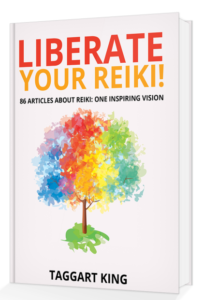
Reiki affects people in different ways, doesn’t it? Whether you are learning Reiki for the first time, or whether you’re receiving Reiki through a course of treatments, there will usually be things that you experience as a result of that Reiki. For some people it will just be a wonderful experience: they will feel calm, content and serene, chilled out, their mood will lift, they will feel free, cleansed, their skin will be clear, they will sleep well and they will be full of energy; they will be really enthusiastic about returning for another dose!
But it’s not always like that. Sometimes Reiki can bring things to the surface, things that need to be acknowledged and released, and this can lead to everything from aches and pains, to a “Reiki cold”, to emotional ups and downs, a frantically busy mind, temporary sleep disruption, a general dissatisfaction with everyone and everything, tiredness and lassitude. It’s temporary and necessary but it’s not fun.
So if we are treating someone, what should we say to people about all this?
Placebos and nocebos
The mind is a very powerful thing. If you have a strong belief about something, that can become your reality. If you believe that a dummy ‘sugar pill’ is going to wake you up, or put you to sleep, it most likely will.
In fact they did an experiment where they took a group of students and either gave them tranquilisers or amphetamines (‘speed’). But they told the students on transquilisers that they were on speed and they told the students on speed that they had been given tranquilisers.
What happened? The tranquilised students were bouncing off the walls, while the cranked-up-to-100mph students were lolling about the place, barely able to keep their eyes open. Their belief about the effects they were going to experience completely trumped the biochemical effects of the drugs that were taking.
So whether you believe a particular treatment is going to produce positive effects for you or produce negative effects, the subconscious mind will try and conjure that up for you. The positive effect is called a ‘placebo’ whereas the negative effect is called a ‘nocebo’.
If you think that a medicine is going to give you terrible side-effects, and you’ve read the accompanying leaflet which lists all the conceivable side-effects that the drug might cause, then you’re more likely to experience those side-effects than if you were blissfully unaware. If your culture tells you that a witch-doctor pointing a bone at you is going to kill you, if that happens then you’re not going to feel too well.
So what do we do with clients?
We don’t want to frighten them into having every possible ‘negative’ reaction to a Reiki treatment, but equally we don’t want to leave them blissfully unaware of the possibility because if they do have a strong reaction, we do want them to know that such a thing may be related to their Reiki treatment and that they shouldn’t worry, or think that the treatment went wrong or was done badly.
We need to be honest
For me the solution would be to be honest with the client and to explain what positve or more challenging effects the treatment might lead to.
But don’t just give them a warning about any negative consequences that they might want to be “on the look out for” because that is not a balanced description and you’re setting them up to be almost waiting for the bad things to happen.
Spend at least as much time, if not more, though, describing the positive experiences that most people tend to have: the “Reiki effect”… the things that most people seem to notice when they receive Reiki. Talk about being calm, content and serene, feeling more positive and better able to cope with stressful situations and people; talk about rest and sleep, energy and state of mind.
That way, you can leave them feeling positive about what is likely to happen, and perhaps you’re introducing a bit of a placebo effect yourself, which can only be a good thing. But you’re also letting them know that if they do notice some more challenging effects, this is perfectly normal and should in fact be viewed in a positive light: Reiki is shifting something, you’re releasing something, it’s passing through and you will end up in a better state as a result of that.
So, be honest with your clients but emphasise the positive, and they’ll leave expecting to experience some of the positive effects you’ve mentioned, but with enough knowledge to understand and feel ok about any more challenging temporary blips that may come to the surface in between sessions with you.
Did you like this blog?
If so, you are going to love this book…

“Whether you are at Level 1, 2 or Reiki Master Teacher Level (regardless of the Reiki flavour you are trained in), this book is very much for you! Within hours of starting to read this book, it has rejuvenated and enriched my own practices with a wealth of information and useful examples too.
The more you read the more you’ll have those wonderful ‘aha’ moments. I know I am already benefiting personally from the knowledge I’ve gained, but so will all my family, friends and clients too. Thank you Taggart for creating this incredible, uniting, enlightening book.”
Heidi Gaffney-Evans
Liberate Your Reiki!
86 Articles About Reiki: One Inspiring Vision
In this Reiki book you will find 80+ articles about Reiki, written by Reiki Master Teacher Taggart King. You will discover how to set your Reiki free, free from the constraints, dogma, rules and regulations of Western-style Reiki courses. Get back to Reiki’s original Japanese method and embrace simplicity, flexibility, creativity and intuition.
This book is suitable for people at all Reiki levels: beginners, those who are developing their Reiki, and Reiki Masters/Master Teachers. You will find advice about self-treatment meditations, energy exercises to build your ability as a channel, you will discover how to work with your intuition and embrace the power of intent.
Explore different distant healing methods and discover the beauty of Reiki’s original Japanese form. Learn how to use creativity and visualisation to enhance your self-treatments and treatment of others, and ditch all the silly rules and regulations that stifle the practice of Western Reiki in many lineages.
Finally, read Taggart King’s “10 Rules of Reiki”, the essential principles for a powerful and fulfilling Reiki practice.
This professionally-printed Reiki manual has 370 A5 pages, a glossy soft cover and we will send it to anywhere in the world!
Read the contents list before you order, if you like, by clicking on this link: Table of contents
Book: 370 pages.
Price: £15.99 + p&p
![]()
Or Download a PDF version now for only £12.49
Photo credit: Varvara

So well explained as usual Thank you Taggart
Thank you, Morag. I’m glad you found it useful 😉